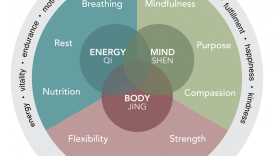The Ultimate Guide to Overcoming Common Challenges in Adopting a Healthy Lifestyle

Importance of Adopting a Healthy Lifestyle
Adopting a healthy lifestyle is crucial for overall well-being. It not only enhances physical health but also boosts mental clarity and emotional stability. Many people begin their journey to a healthier life driven by the desire to improve energy levels, manage weight, or prevent chronic diseases. Consider this: investing time in healthy habits today can pay off significantly in the long term. Some key benefits include:
- The Ultimate Guide to Overcoming Common Challenges in Adopting a Healthy Lifestyle
- Importance of Adopting a Healthy Lifestyle
- Common Challenges Faced
- Setting Realistic Goals
- Understanding Your Why
- Creating a Realistic Action Plan
- Overcoming Time Constraints
- Time Management Techniques
- Incorporating Quick Workouts
- Dealing with Temptations
- Strategies for Resisting Temptations
- Building a Support System
- Finding Enjoyable Physical Activities
- Exploring Different Workout Options
- Making Fitness Fun
- Overcoming Emotional Eating
- Identifying Triggers
- Developing Healthy Coping Mechanisms
- Managing Stress Levels
- Stress-Relief Techniques
- Prioritizing Self-Care
- Establishing a Healthy Sleep Routine
- Importance of Quality Sleep
- Tips for Better Sleep
- Overcoming Plateaus
- Reassessing Goals
- Trying New Workouts
- Staying Consistent
- Forming Healthy Habits
- Tracking Progress
- Building a Positive Mindset
- Practicing Gratitude
- Cultivating Self-Compassion
- Celebrating Milestones
- Recognizing Achievements
- Rewarding Yourself
- Seeking Professional Guidance
- Consulting with a Nutritionist
- Working with a Personal Trainer
- Embracing the Journey
- Enjoying the Process
- Embracing Setbacks
- Conclusion
- Reflecting on Your Progress
- Committing to a Lifelong Healthy Lifestyle
- Increased energy levels
- Reduced risk of chronic diseases
- Improved mood and mental health
- Better sleep quality
Common Challenges Faced
Despite the numerous benefits, embracing a healthy lifestyle can be fraught with challenges. Many individuals encounter obstacles such as:
- Time Constraints: Juggling work, family, and personal interests often makes it difficult to dedicate time to healthy activities.
- Unhealthy Temptations: From fast food to sugary snacks, highly processed items are readily available, making it hard to stick to nutritious choices.
- Emotional Factors: Stress and emotional eating can derail the best intentions, leading to unhealthy coping mechanisms.
Recognizing these challenges is the first step toward overcoming them and staying committed to lasting lifestyle changes.
Setting Realistic Goals
Understanding Your Why
Before diving into a healthier lifestyle, it’s vital to understand your “why.” What motivates you? Is it the desire to play with your children without getting winded, or maybe it’s to feel more confident in your own skin? Pinpointing your motivation provides a strong foundation for your journey. Ask yourself:
- What specific benefits do I want?
- How will achieving these goals change my life?
- What long-term impact do I envision?
By clarifying your reasons, you create a personal connection with your goals, making it easier to stay committed.
Creating a Realistic Action Plan
With a solid understanding of your motivations, the next step involves crafting a realistic action plan. Set achievable and measurable goals, considering your current lifestyle and obligations. Here’s how to create your plan:
- Start Small: Instead of overhauling your diet or workout routine overnight, aim for gradual changes, like adding one vegetable to each meal.
- Set Specific Goals:
- Aim for 30 minutes of activity three times a week.
- Replace sugary drinks with water a few times a week.
- Make it Measurable: Track your progress with a journal or app to celebrate small wins along the way.
- Stay Flexible: Life can be unpredictable. If you miss a workout or indulge in a treat, don’t get discouraged; adjust your plan as necessary.
By understanding your motivations and creating a realistic action plan, you lay the foundation for success in your healthy lifestyle journey.
Overcoming Time Constraints
Time Management Techniques
Even with the best intentions, busy schedules often pose significant barriers to adopting a healthy lifestyle. However, implementing effective time management techniques can help carve out those essential minutes for self-care. Consider these strategies:
- Prioritize Tasks: Use a to-do list and highlight health-related activities, such as meal prep or exercise, alongside daily responsibilities.
- Plan Your Week: Devote a few minutes every Sunday to schedule workouts and meals, transforming them into non-negotiables.
- Set Time Limits: Break tasks into manageable chunks with set durations; you’ll find it easier to focus and be more productive.
Incorporating Quick Workouts
When time is tight, quick workouts can be a lifesaver. You don’t need an hour at the gym to reap the benefits of physical activity! Instead, consider these efficient strategies:
- HIIT (High-Intensity Interval Training): These short bursts of intense activity followed by brief rest periods can deliver impressive results in as little as 20 minutes. Try combining exercises like jumping jacks, squats, and burpees for a full-body burn.
- Take Advantage of Breaks: Sneak in short bursts of activity during breaks at work. A quick 5-minute walk or some chair exercises can elevate your heart rate.
- Use Online Resources: Plenty of apps and videos offer quick, effective workout routines that fit into even the busiest schedules.
By mastering time management techniques and incorporating quick workouts, individuals can successfully navigate their busy lives while still prioritizing health and fitness.
Dealing with Temptations
Strategies for Resisting Temptations
Navigating through the myriad of temptations daily can be challenging. Whether it’s the call of a sugary treat at work or the convenience of a fast-food restaurant, having strategies in place can make a significant difference. Here are some effective approaches:
- Mindful Eating: Take a moment to pause and assess your hunger. Ask yourself if you’re truly hungry or just bored.
- Healthy Alternatives: Stock up on nutritious snacks like fruits, nuts, or yogurt. When cravings strike, reaching for a healthy option can satisfy you without derailing progress.
- Set Boundaries: Allow yourself occasional treats, but set limits. For example, indulge in dessert once a week instead of daily.
Building a Support System
Creating a robust support system is also essential when battling temptations. Surrounding yourself with like-minded people can provide motivation and accountability. Consider these tips:
- Share Your Goals: Inform friends and family about your healthy lifestyle goals. Their encouragement can bolster your resolve and help you resist temptations.
- Join a Community: Engage with local fitness groups, online forums, or social media challenges. Connecting with others on a similar journey fosters a sense of belonging and support.
- Be Open About Struggles: Don’t hesitate to share when cravings hit hard. Sharing can often diffuse the intensity of the temptation and lead to practical solutions.
By employing effective strategies for resisting temptations and building a supportive network, individuals can better navigate their healthy lifestyle journeys with resilience and strength.
Finding Enjoyable Physical Activities
Exploring Different Workout Options
Finding enjoyable physical activities is a crucial step in maintaining a healthy lifestyle. Exercise shouldn’t feel like a chore; instead, it can be a fun and fulfilling part of your day. Exploring different workout options can lead you to discover what truly excites you. Consider trying:
- Dance Classes: Whether it’s Zumba, salsa, or hip-hop, dancing can be a fantastic way to stay fit while having a blast.
- Outdoor Activities: Hiking, cycling, or even kayaking offers a refreshing change from indoor workouts while enjoying nature.
- Group Sports: Joining a local sports team, like soccer or basketball, allows you to make friends while staying active.
Making Fitness Fun
Once you find what you enjoy, the next step is to infuse fun into your fitness routine. This could mean adding a playful twist to your workouts. Here are some tips to make fitness enjoyable:
- Set Fun Challenges: Engage friends in friendly competitions, like step-count challenges or weekend workout meet-ups.
- Music and Podcasts: Curate an energetic playlist or listen to podcasts that interest you while working out. These can make the time fly by.
- Reward Yourself: Celebrate your achievements with small rewards, such as new workout gear or a massage.
By exploring various workout options and incorporating fun elements into your exercise routine, individuals can cultivate a positive attitude toward fitness that encourages consistent engagement and enjoyment.
Overcoming Emotional Eating
Identifying Triggers
Emotional eating can often derail progress on the journey to a healthier lifestyle. The first step in overcoming it is identifying the triggers that lead to these eating patterns. Reflecting on your emotional state during cravings can offer valuable insights. Consider these common triggers:
- Stress: Many people turn to food as a comfort during stressful times.
- Boredom: Eating out of sheer boredom can lead to unnecessary snacking.
- Emotional Events: Celebrations or memories tied to food can prompt overeating.
Keeping a journal can be beneficial. Documenting when and why you eat can help uncover patterns and raise awareness.
Developing Healthy Coping Mechanisms
Once you’ve identified your triggers, the next step is to develop healthier coping mechanisms. Instead of reaching for snacks when emotions run high, consider these alternatives:
- Engage in Physical Activity: A brisk walk or a quick workout can channel those emotions positively.
- Practice Mindfulness: Techniques like meditation or deep breathing can help center you and alleviate stress without turning to food.
- Connect with Others: Reaching out to friends or loved ones for conversation can provide comfort and distraction.
By recognizing triggers and implementing healthier coping strategies, individuals can break the cycle of emotional eating and nurture a more mindful relationship with food.
Managing Stress Levels
Stress-Relief Techniques
Managing stress is essential not only for your mental well-being but also for maintaining healthy eating habits and achieving fitness goals. There are several effective stress-relief techniques that can help you reclaim your inner calm. Consider incorporating these into your daily routine:
- Deep Breathing Exercises: Take a few minutes each day to practice deep breathing. Inhale slowly for a count of four, hold for four, and exhale for four. This simple technique can significantly reduce anxiety.
- Progressive Muscle Relaxation: Tense and then relax different muscle groups in your body. This method helps to relieve tension and promote relaxation.
- Mindfulness Meditation: Spend just five to ten minutes focusing on your breath and observing your thoughts without judgment. This practice cultivates awareness and serenity.
Prioritizing Self-Care
In addition to stress-relief techniques, prioritizing self-care is crucial. Taking time for yourself can help recharge your batteries and boost resilience against stressors. Here are some self-care practices to consider:
- Schedule “Me Time”: Block out time each week for activities that bring you joy, whether it’s reading, gardening, or indulging in a hobby.
- Set Boundaries: Learn to say no when you feel overwhelmed. Protecting your time is vital for managing stress.
- Nurture Your Sleep: Quality sleep is essential for stress management. Aim for 7-9 hours of uninterrupted sleep each night to help your body recover and rejuvenate.
By implementing effective stress-relief techniques and prioritizing self-care, individuals can better navigate life’s challenges and foster a healthier, more balanced lifestyle.
Establishing a Healthy Sleep Routine
Importance of Quality Sleep
Following a strategic focus on stress management, it’s important to recognize the crucial role quality sleep plays in achieving a healthier lifestyle. Quality sleep not only improves your mood and cognitive function but also enhances your body’s ability to heal and regenerate. Sleep deprivation can lead to increased cravings, poor decision-making, and even emotional eating. Aiming for consistent, restorative sleep can boost energy levels, improve focus, and heighten your overall sense of well-being.
Tips for Better Sleep
To establish a healthy sleep routine, consider implementing these helpful tips:
- Create a Sleep Schedule: Go to bed and wake up at the same time every day, even on weekends. This consistency helps regulate your body’s internal clock.
- Limit Screen Time: Reduce exposure to screens at least an hour before bedtime. The blue light emitted can interfere with the production of the sleep hormone melatonin.
- Create a Relaxing Bedtime Ritual: Engage in calming activities, such as reading, gentle yoga, or taking a warm bath, to signal to your body that it’s time to wind down.
- Create a Comfortable Sleep Environment: Ensure your bedroom is dark, cool, and quiet. Consider using blackout curtains or a white noise machine to enhance your sleep environment.
By understanding the importance of quality sleep and incorporating these tips into your routine, individuals can significantly improve their overall health and well-being, setting the stage for a more vibrant life.
Overcoming Plateaus
Reassessing Goals
After establishing a consistent routine and focusing on quality sleep, you might encounter a plateau, where your progress seems to stall. This is a common experience in any fitness journey. The first step in overcoming this plateau is to reassess your goals. Reflect on what you’ve achieved and consider whether your goals are still relevant and realistic.
- Set New Challenges: If you’ve hit a weight loss target, think about shifting your focus to strength training or improving endurance.
- Break Goals into Smaller Milestones: Instead of one large goal, set mini-goals that can boost your motivation along the way.
Trying New Workouts
Another effective strategy for breaking through a plateau is to try new workouts. Introducing variety into your routine can stimulate different muscle groups and reignite your enthusiasm. Consider these options:
- Cross-Training: Mix different forms of exercise, such as swimming, cycling, or yoga, to keep things interesting.
- Join a Class: Try group fitness classes like kickboxing or HIIT. The energetic environment often provides extra motivation.
- Change Your Routine: If you’ve been focusing on running, switch to strength training, or vice versa.
By reassessing your goals and trying new workouts, you can energize your fitness journey and continue making progress toward a healthier lifestyle.
Staying Consistent
Forming Healthy Habits
After overcoming plateaus, the next challenge is staying consistent in your healthy lifestyle journey. A key to consistency lies in forming healthy habits that seamlessly integrate into your daily routine. Focus on small, achievable changes that can lead to lasting results. Consider implementing these strategies:
- Start Small: Begin with manageable goals, like drinking more water or taking a 10-minute walk each day.
- Create Routines: Incorporate healthy activities into your daily schedule, making them a non-negotiable part of your day.
- Be Patient: Understand that habit formation takes time. Research suggests it can take anywhere from 18 to 254 days to form a new habit, depending on the individual.
Tracking Progress
In addition to forming healthy habits, tracking your progress is vital for staying accountable and motivated. Recording your journey allows you to see how far you’ve come and adjust your strategies as needed. Here are some ways to track your progress effectively:
- Use a Journal or App: Document your workouts, meals, and emotions. This practice can help identify patterns and areas for improvement.
- Set Regular Check-Ins: Schedule weekly or monthly evaluations to assess your goals and celebrate your successes.
- Visualize Your Journey: Consider using charts or graphs to see your progress over time. Visual representations can be motivating and rewarding.
By focusing on forming healthy habits and actively tracking progress, individuals can cultivate consistency in their healthy lifestyle, leading to long-term success and fulfillment.
Building a Positive Mindset
Practicing Gratitude
After establishing consistency in your routine, building a positive mindset becomes essential for sustaining your healthy lifestyle. Practicing gratitude is an incredibly effective way to cultivate positivity. Reflecting on what you appreciate can shift your focus from challenges to the blessings in your life. Start by:
- Keeping a Gratitude Journal: Each day, jot down three things you’re grateful for. This simple practice can enhance your mood and reinforce a positive outlook.
- Sharing with Others: Express your gratitude to someone. Whether it’s a quick text or a heartfelt conversation, sharing gratitude can strengthen relationships.
Cultivating Self-Compassion
In addition to gratitude, cultivating self-compassion is crucial for maintaining a positive mindset. Being kind to yourself during challenges enhances resilience and helps prevent feelings of discouragement. Consider these strategies:
- Acknowledge Your Feelings: Recognize and accept your emotions without judgment. Instead of criticizing yourself when things don’t go as planned, remind yourself that everyone faces setbacks.
- Practice Positive Self-Talk: Replace negative thoughts with affirmations. For instance, instead of thinking, “I can’t do this,” try reframing to, “I’m learning and improving every day.”
By embracing gratitude and fostering self-compassion, individuals can fortify their positive mindset, providing a strong foundation for enduring success in their healthy lifestyle journey.
Celebrating Milestones
Recognizing Achievements
As you progress on your healthy lifestyle journey, it’s essential to celebrate milestones along the way. Recognizing your achievements, no matter how big or small, reinforces your commitment and fosters motivation. Celebrating these moments can enhance your overall experience and encourage continued dedication. Consider these ways to acknowledge your progress:
- Create a Milestone Chart: Visually track your goals and mark each achievement. This can serve as a tangible reminder of how far you’ve come.
- Reflect on Your Journey: Take time to journal about your experiences, noting challenges you’ve overcome and lessons learned.
Rewarding Yourself
In addition to recognizing achievements, rewarding yourself can provide added motivation. Treating yourself for reaching a goal reinforces your hard work and commitment. Here are some reward ideas:
- Set Non-Food Rewards: Treat yourself to a new workout outfit, a spa day, or a fun outing with friends. These non-food rewards can signify your success without compromising your progress.
- Plan a Special Experience: Consider treating yourself to a weekend getaway or a fun class you’ve always wanted to try. These memorable experiences can motivate you to continue on your journey.
By acknowledging achievements and rewarding yourself appropriately, individuals can create a positive reinforcement cycle that enhances their dedication to a healthier lifestyle.
Seeking Professional Guidance
Consulting with a Nutritionist
As you continue to celebrate milestones in your health journey, seeking professional guidance can elevate your efforts to the next level. Consulting with a nutritionist offers personalized insight tailored to your unique dietary needs and goals. Consider the following benefits:
- Customized Meal Plans: A nutritionist can create meal plans that suit your lifestyle, preferences, and health objectives.
- Balanced Nutrient Intake: They help ensure you’re getting the right balance of nutrients to support your activity level and overall health.
- Education and Support: Nutritionists can provide valuable education about food choices, portion sizes, and how to read labels effectively.
Working with a Personal Trainer
In addition to nutritional guidance, working with a personal trainer can enhance your fitness routine. A trainer provides personalized workouts that align with your goals, making your path to fitness more efficient and effective. Here are some advantages:
- Tailored Fitness Programs: Trainers create workout plans specifically designed for your needs, whether you’re aiming to lose weight, build strength, or improve endurance.
- Motivation and Accountability: Having scheduled sessions with a trainer fosters accountability, making it less likely for you to skip workouts.
- Proper Technique Guidance: Trainers ensure you perform exercises correctly, reducing the risk of injury and maximizing results.
By consulting with a nutritionist and working with a personal trainer, individuals can gain valuable insights and support, empowering them to reach their health and fitness goals more effectively.
Embracing the Journey
Enjoying the Process
After seeking professional guidance, it’s essential to embrace the journey toward a healthier lifestyle fully. Instead of fixating solely on the end goals, find joy in the process itself. Celebrate the small victories, such as feeling more energetic or discovering a new favorite healthy recipe. Here are some ways to enjoy the journey:
- Explore New Activities: Try different workouts, such as dance classes or hiking, to discover what makes you happy.
- Connect with Others: Share your experiences with friends or join a group with similar goals to foster a sense of community.
Embracing Setbacks
Setbacks are an inevitable part of any journey, and learning to embrace them enhances resilience. Instead of viewing setbacks as failures, frame them as opportunities for growth and learning. Consider these strategies:
- Reflect and Adjust: When faced with a challenge, take a moment to reflect on what triggered it and how to adjust your approach moving forward.
- Practice Patience: Remind yourself that progress is not linear. Embracing the ups and downs can deepen your commitment to your health journey.
By enjoying the process and embracing setbacks as learning experiences, individuals can cultivate a more fulfilled and resilient approach to their healthy lifestyle journey.
Conclusion
Reflecting on Your Progress
As you reach the conclusion of your journey toward a healthier lifestyle, take the time to reflect on your progress. Appreciate the strides you’ve made, from overcoming challenges to celebrating milestones. Reflecting on how far you’ve come fosters gratitude and deepens your understanding of what works best for you. Consider these prompts:
- What challenges did you overcome?
- What achievements are you most proud of?
- How have your habits developed or changed?
Committing to a Lifelong Healthy Lifestyle
Finally, commit to embracing a lifelong healthy lifestyle. Instead of seeing health as a destination, view it as an ongoing journey filled with learning and growth. Here are some ways to maintain your commitment:
- Set New Goals: Keep challenging yourself by setting new health and fitness goals regularly.
- Stay Informed: Continue educating yourself on nutrition and fitness trends to make informed choices.
- Seek Support: Engage with communities that inspire and motivate you to stay on track.
By reflecting on your journey and committing to lifelong health, you empower yourself to lead a fulfilling, vibrant life. Embrace the adventure ahead with an open heart and a positive mindset!





